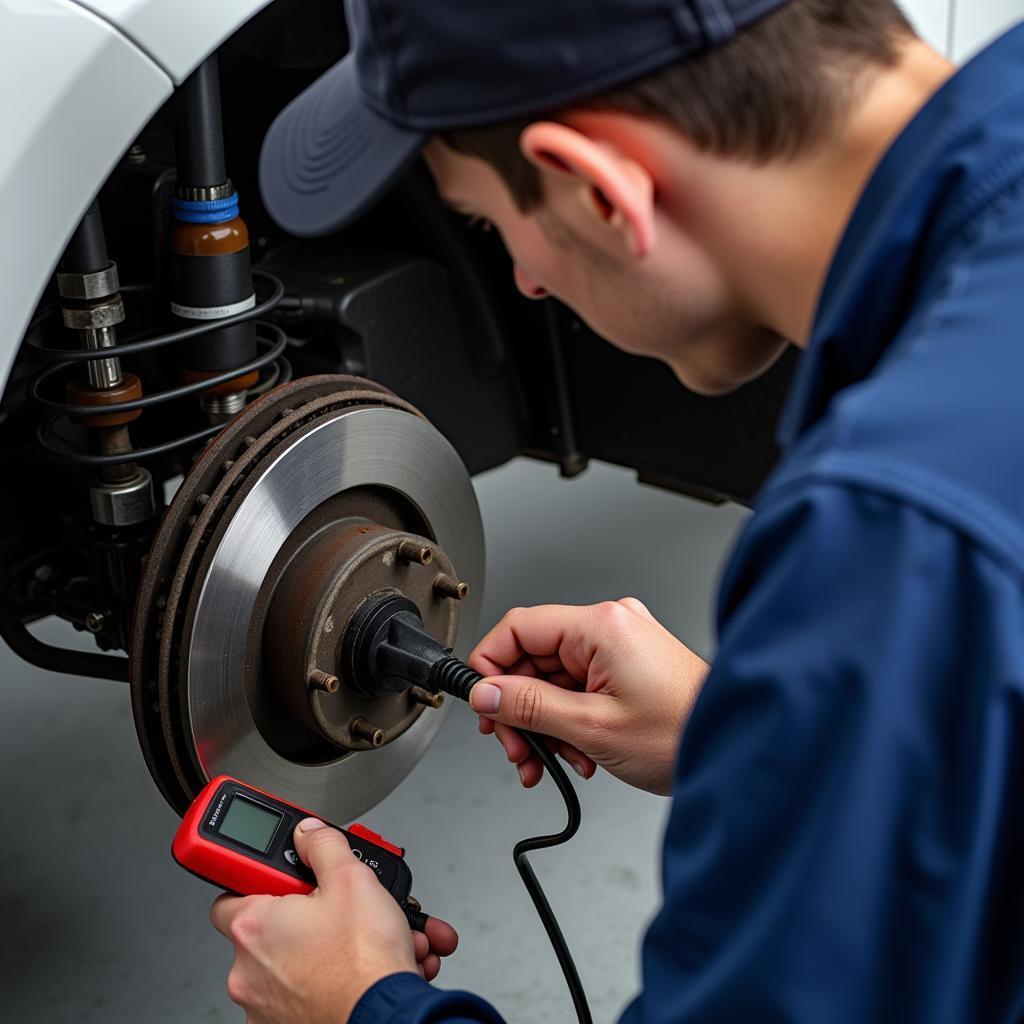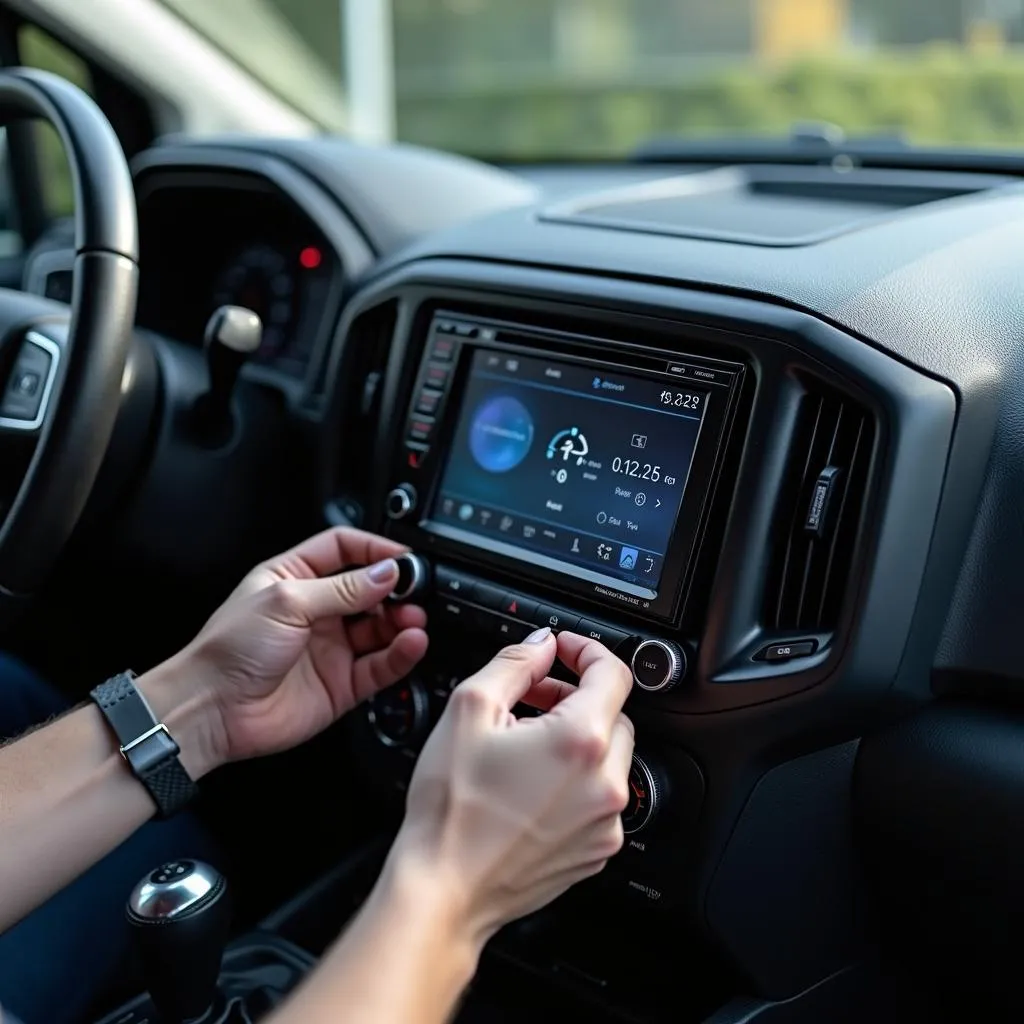The anti lock brake warning light comes on, and suddenly you’re filled with a sense of unease. What does it mean? Is it safe to drive? This article will guide you through understanding why your ABS light is illuminated, how to diagnose the problem, and the potential solutions available. We’ll also explore preventative measures to keep your ABS system functioning optimally.
The ABS warning light, often amber or yellow, signifies a potential issue with your Anti-lock Braking System (ABS). This crucial safety feature prevents wheel lockup during hard braking, allowing you to maintain steering control. Ignoring this warning light could compromise your safety and lead to more extensive and costly repairs down the line. Let’s delve into the common causes and solutions.
Understanding the ABS System and Warning Light
The ABS comprises several key components, including wheel speed sensors, a hydraulic control unit, and a pump. These components work together to monitor wheel speed and regulate brake pressure, preventing skids and maintaining control. When the anti lock brake warning light comes on, it indicates a fault within this system.
A common misconception is that an illuminated ABS light means your regular brakes are malfunctioning. This is not true. Your conventional braking system will still function, but without the added safety net of ABS. This is particularly crucial in slippery conditions, where the absence of ABS can significantly increase stopping distances. After the initial diagnosis, it’s vital to determine the root cause and implement appropriate repairs.
Here’s where remote diagnostics and software solutions come into play. These advanced tools allow experienced technicians to access your vehicle’s computer system remotely, pinpoint the exact issue, and even reprogram certain modules without physical intervention. This can save you time and money compared to traditional diagnostic methods. Read more about brake pad warning light issues on Mercedes vehicles if you own one.
Common Causes of an Illuminated ABS Warning Light
Several factors can trigger the ABS warning light. Some of the most common include:
- Low Brake Fluid: Insufficient brake fluid can disrupt the hydraulic pressure required for ABS operation.
- Faulty Wheel Speed Sensors: These sensors provide crucial data to the ABS control unit. A malfunctioning sensor can cause the system to malfunction.
- ABS Control Unit Issues: The ABS control unit is the brain of the system. Problems with this unit can lead to a range of ABS-related issues.
- Damaged Wiring or Connectors: Corroded or damaged wiring can interrupt communication within the ABS system.
- Blown Fuse: A blown fuse can cut off power to the ABS system, triggering the warning light.
It’s essential to address these issues promptly to ensure your safety on the road.
Diagnosing the Problem: Remote Diagnostics and Software Solutions
Traditional diagnostic methods often involve physically connecting a scan tool to your vehicle’s OBD-II port. While effective, this approach requires a trip to a repair shop. Remote diagnostics offer a more convenient alternative. Using specialized software, technicians can access your car’s computer system remotely, read diagnostic trouble codes (DTCs), and identify the source of the problem. If you are experiencing a red brake warning light on your BMW, learn more about it here.
This technology is particularly useful for addressing software-related issues within the ABS system. For instance, if a software glitch is causing the ABS light to illuminate, a technician can remotely reprogram the ABS module with the latest software version, resolving the problem without any physical intervention. This approach can save you valuable time and money. Furthermore, it offers a convenient solution for those who live in remote areas with limited access to qualified repair shops.
Having issues with the red brake warning light on your BMW X5? Click here for more information.
DIY Troubleshooting Steps
While remote diagnostics and software solutions offer advanced diagnostic capabilities, there are a few simple checks you can perform yourself before seeking professional help:
- Check Brake Fluid Level: Ensure the brake fluid reservoir is full. Low brake fluid can trigger the ABS warning light.
- Inspect Wiring and Connectors: Visually examine the wiring and connectors leading to the ABS components for any signs of damage or corrosion.
- Check Fuses: Locate the ABS fuse in your vehicle’s fuse box and check if it’s blown. Replace it if necessary.
If these simple checks don’t resolve the issue, it’s time to seek professional assistance.
Professional Repair Options
If you’ve tried the basic troubleshooting steps and the anti lock brake warning light persists, you’ll likely need professional help. Here are a few options:
- Remote Diagnostics and Programming: As discussed earlier, remote diagnostics offer a convenient and efficient way to pinpoint and resolve ABS issues.
- Local Repair Shop: A qualified mechanic can diagnose and repair more complex ABS problems, such as faulty wheel speed sensors or a malfunctioning ABS control unit.
Choosing the right repair option depends on the complexity of the problem and your personal preferences. Find out more about the 2005 Honda Accord brake warning light if you own this model.
 Mechanic Inspecting ABS System
Mechanic Inspecting ABS System
Preventing Future ABS Issues
Regular maintenance is crucial for preventing ABS problems. Here are a few tips to keep your ABS system in optimal condition:
- Regular Brake Fluid Checks and Changes: Ensure your brake fluid is at the correct level and change it according to your vehicle manufacturer’s recommendations.
- Wheel Speed Sensor Inspection: Have your wheel speed sensors checked during routine maintenance to ensure they are functioning correctly. For information on Audi A6 brake servo warning light, visit this page.
Conclusion
The anti lock brake warning light coming on should never be ignored. Understanding the potential causes, utilizing remote diagnostics and software solutions, and taking preventative measures can ensure your ABS system remains functional and keeps you safe on the road. Addressing the issue promptly can prevent further damage and ensure your peace of mind behind the wheel.
FAQ
- Is it safe to drive with the ABS light on? You can still drive, but your ABS won’t function. Exercise extra caution, especially in slippery conditions.
- Can I reset the ABS light myself? While you can sometimes reset it by disconnecting the battery, it’s best to diagnose and fix the underlying issue.
- How much does it cost to fix an ABS problem? The cost varies depending on the cause. Remote diagnostics and software solutions can be more cost-effective than traditional repairs.
- How often should I check my brake fluid? Check it at least once a month and top it off if necessary.
- Can I prevent ABS issues? Regular maintenance, including brake fluid changes and sensor inspections, can help prevent problems.
- What is the difference between ABS and regular brakes? ABS prevents wheel lockup during hard braking, allowing you to maintain steering control. Regular brakes simply slow the vehicle.
- What should I do if the ABS light comes on and stays on? Seek professional diagnostics and repair to identify and fix the underlying problem.


